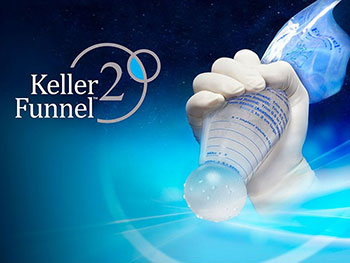

Breast augmentation is the most popular plastic surgical procedure in the United States. While satisfaction rates are extremely high, complications can occur. Two common complications with breast augmentation are capsular contracture and implant failure resulting from trauma to the implant: gel fracture or rupture. The Keller Funnel was designed to dramatically lower these complications and to allow for smaller and less visible incisions.
Capsular Contracture
Capsular contracture is a term which describes a hard or pathologic condition where scar tissue builds up around the implant. In response to any breast implant, the body will form a thin layer of protective tissue around the implant known as a capsule. If the capsule stays soft it is not noticable to the patient and causes no problem in the short or long term. However, if the capsule becomes firm then the implant and breast can become distorted and painful. Capsular contractures are difficult to treat and often require return to the operating room for removal in a procedure known as a capsulectomy.
Capsules are graded on the Baker Grading scale:
| Baker Grade I | The breast is soft and appears natural in size and shape |

|
| Baker Grade II | The breast is a little firm, but appears normal |

|
| Baker Grade III | The breast is firm and appears abnormal |  |
| Baker Grade IV | The breast is hard, painful to the touch, and appears abnormal |  |

Estimates are that about 5% of breast augmentation patients will get a capsular contracture. While this number may seem small, the problem is difficult to manage and can permanently affect the result. One theory behind the cause of capsular contracture is bacterial contamination of the implant and/or implant pocket.
Implant Trauma
Bacterial contamination can be caused by improper technique when placing the implant. Most surgeons will use a finger probing technique where the implant is forced into the pocket making contact with the skin on it's way into the pocket. This process is quite traumatic and can also result in trauma or rupture of the implant.

The Keller Funnel provides a sterile and "no touch" technique when placing the implant. The implant is placed directly into the funnel and then gently directed into the breast pocket without ever being touched or forced. This avoids possible bacterial contamination and trauma to the implant. The Keller funnel is a nylon pouch shaped like an icing bag, and is coated with a proprietary lubricant called LubriLAST. To improve lubrication, both the funnel and the implant are submerged in a saline or anti-bacterial solution during breast augmentation with the Keller funnel.

The doctor holds the Keller funnel in place while the nurse pours the implant into it from the original packaging. After the narrower end of the funnel is placed into the incision, the doctor squeezes the implant into the breast. Compared to the finger push method, an independent study has shown that using the Keller funnel during breast enhancement surgery reduces the forces applied on an implant by 95%.
Breast augmentation with the Keller funnel can be performed on transaxial, periareolar, or inframammary procedures. Both smooth and textured implants of up to 800 cc have been used successfully with the Keller funnel, but textured implants require more pressure applied on them. Implant manufacturer recommendations must be kept in mind, although smaller incisions can be made while performing breast augmentation with the Kennel funnel.
To ensure cleanliness, each Keller funnel is used only in one surgery which counts both breasts and an insertion test. Reviewing the benefits of the Keller funnel, breast surgery using this method requires smaller incisions than traditional breast augmentation procedures. Doctor and patient can now have more options on where to place the incisions during surgery because smaller incisions are needed.
The presence of bacteria is very low thanks to the no touch technique utilized.
The implant is less likely to tear because the forces being used during the breast augmentation surgery are less than usual. After the operation, patients heal at a faster pace and acclimate to their implant easier.
